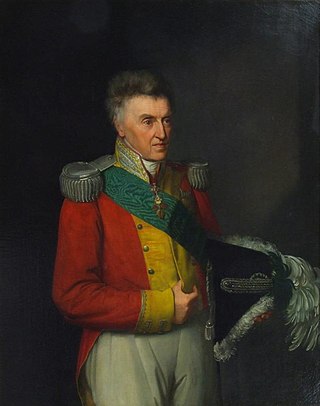
Anthony of Saxony was a King of Saxony from the House of Wettin. He became known as Anton der Gütige.

Saxony, officially the Free State of Saxony, is a landlocked state of Germany, bordering the states of Brandenburg, Saxony-Anhalt, Thuringia, and Bavaria, as well as the countries of Poland and the Czech Republic. Its capital is Dresden, and its largest city is Leipzig. Saxony is the tenth largest of Germany's sixteen states, with an area of 18,413 square kilometres (7,109 sq mi), and the sixth most populous, with more than 4 million inhabitants.

Dresden is the capital city of the German state of Saxony and its second most populous city after Leipzig. It is the 12th most populous city of Germany, the fourth largest by area, and the third most populous city in the area of former East Germany, after Berlin and Leipzig. Dresden's urban area comprises the towns of Freital, Pirna, Radebeul, Meissen, Coswig, Radeberg and Heidenau and has around 790,000 inhabitants. The Dresden metropolitan area has approximately 1.34 million inhabitants.
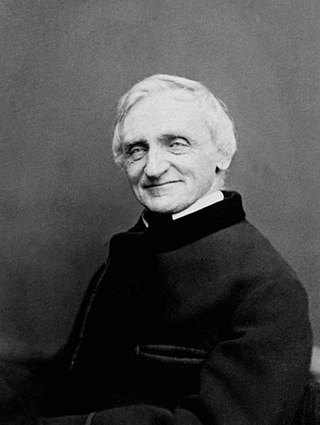
John was King of Saxony from 9 August 1854 until his death in 1873. He was a member of the House of Wettin. During his reign, Saxony became a part of the German Empire.
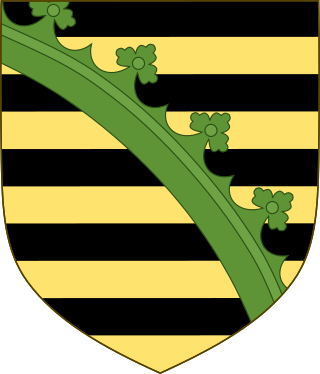
The House of Wettin was a dynasty which included Saxon kings, prince-electors, dukes, and counts, who once ruled territories in the present-day German federated states of Saxony, Saxony-Anhalt and Thuringia. The dynasty is one of the oldest in Europe, and its origins can be traced back to the town of Wettin, Saxony-Anhalt. The Wettins gradually rose to power within the Holy Roman Empire. Members of the family became the rulers of several medieval states, starting with the Saxon Eastern March in 1030. Other states they gained were Meissen in 1089, Thuringia in 1263, and Saxony in 1423. These areas cover large parts of Central Germany as a cultural area of Germany.
TU Dresden, also as the Dresden University of Technology, is a public research university in Dresden, Germany. It is the largest institute of higher education in the city of Dresden, the largest university in Saxony and one of the 10 largest universities in Germany with 32,389 students as of 2018.
Central Germany is an economic and cultural region in Germany. Its exact borders depend on context, but it is often defined as being a region within the federal states of Saxony, Thuringia and Saxony-Anhalt, or a smaller part of this region, such as the metropolitan area of Leipzig and Halle plus the surrounding counties.

The Electorate of Saxony, also known as Electoral Saxony, was a territory of the Holy Roman Empire from 1356 to 1806 initially centred on Wittenberg that came to include areas around the cities of Dresden, Leipzig and Chemnitz. It was a major Holy Roman state, being an electorate and the original protecting power of Protestant principalities until that role was later taken by its neighbor, Brandenburg-Prussia.
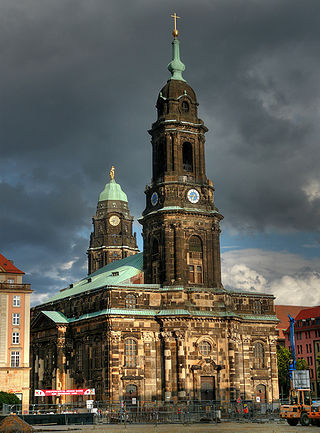
The Dresden Kreuzkirche is a Lutheran church in Dresden, Germany. It is the main church and seat of the Landesbischof of the Evangelical-Lutheran Church of Saxony, and the largest church building in the Free State of Saxony. It also is home of the Dresdner Kreuzchor boys' choir.

The Royal Saxon State Railways were the state-owned railways operating in the Kingdom of Saxony from 1869 to 1918. From 1918 until their merger into the Deutsche Reichsbahn the title 'Royal' was dropped and they were just called the Saxon State Railways.

The Hannah Arendt Institute for Totalitarianism Studies is a research institute hosted by Dresden University of Technology and devoted to the comparative analysis of dictatorships. The institute focusses particularly on the structures of Nazism and Communism as well as on the presuppositions and consequences of the two ideological dictatorships. The institute is named after the German-American philosopher and political scientist Hannah Arendt, whose magnum opus The Origins of Totalitarianism (1951) is considered across disciplines as one of the most influential works of the 20th century and continues to shape in particular scholarly discussions of totalitarian systems of political domination.
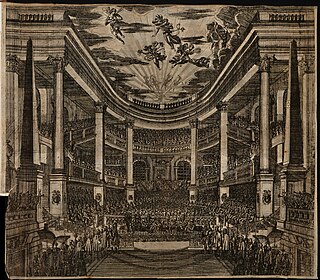
The Opernhaus am Taschenberg was a theatre in Dresden, Saxony, Germany, built from 1664 to 1667 by Wolf Caspar von Klengel. It was the first opera house of the capital of Saxony, Residenz of the Elector of Saxony. Seating up to 2000 people, it was at the time one of the largest opera houses in Europe. It was also called Klengelsches Opernhaus and Komödienhaus am Taschenberg.

Hugo Hickmann was a German politician.

Olga Körner was a German political activist and a co-founder of the proletarian women's movement in Dresden. Between 1930 and 1933 she sat as a member of the national parliament ("Reichstag").
Margarete Nischwitz was a German political activist and politician (KPD). She sat as a member of the Saxony regional parliament (Landtag) in Dresden between 1929 and 1933.

"Meinen Jesum laß ich nicht" is a German Lutheran hymn, with lyrics by Christian Keimann written in 1658. The theme of the hymn is trust in Jesus, based on memorial sermons for John George I, Elector of Saxony recalling conversations of the elector with his minister on his deathbed.
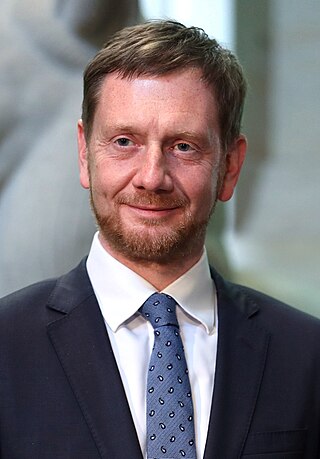
Michael Kretschmer is a German politician of the Christian Democratic Union (CDU) who has been serving as Minister President of Saxony since December 2017. Since 2022, he has been one of four deputy chairs of the CDU, under the leadership of chairman Friedrich Merz.

Wächter is a series of large outdoor iron sculptures by Anatol Herzfeld, a student of Joseph Beuys who was both a traffic policeman and an artist, with a recurring theme. The sculptures are located at various places in Germany. One of them watches over a positive change in the environment, another is a monument to policemen killed in the line of duty.

Kreishauptmannschaft Bautzen was a Kreishauptmannschaft or administrative district in the Kingdom of Saxony. It was founded in 1835 and continued under the Free State of Saxony until abolished in 1934.
Kreishauptmannschaft Leipzig was a Kreishauptmannschaft or administrative district in the Kingdom of Saxony. Succeeding the Leipziger Kreis of the Electorate of Saxony, it was founded in 1835 and continued under the Free State of Saxony until being renamed the 'Regierungsbezirk Leipzig' in 1939, headed by Erich Teichmann (1882-?) as Regierungspräsident. The Kreishauptmannschaft system was abolished in 1943.















